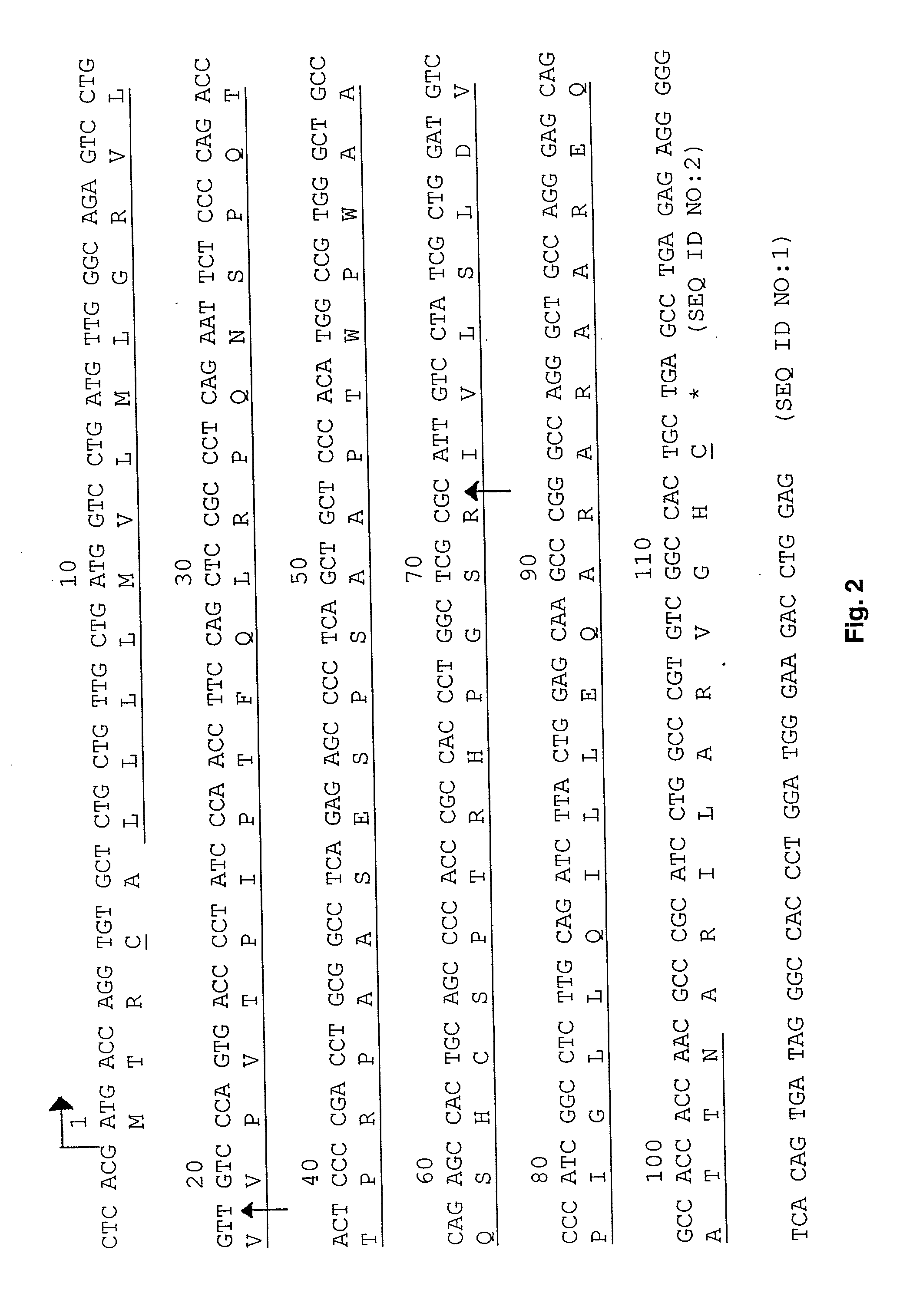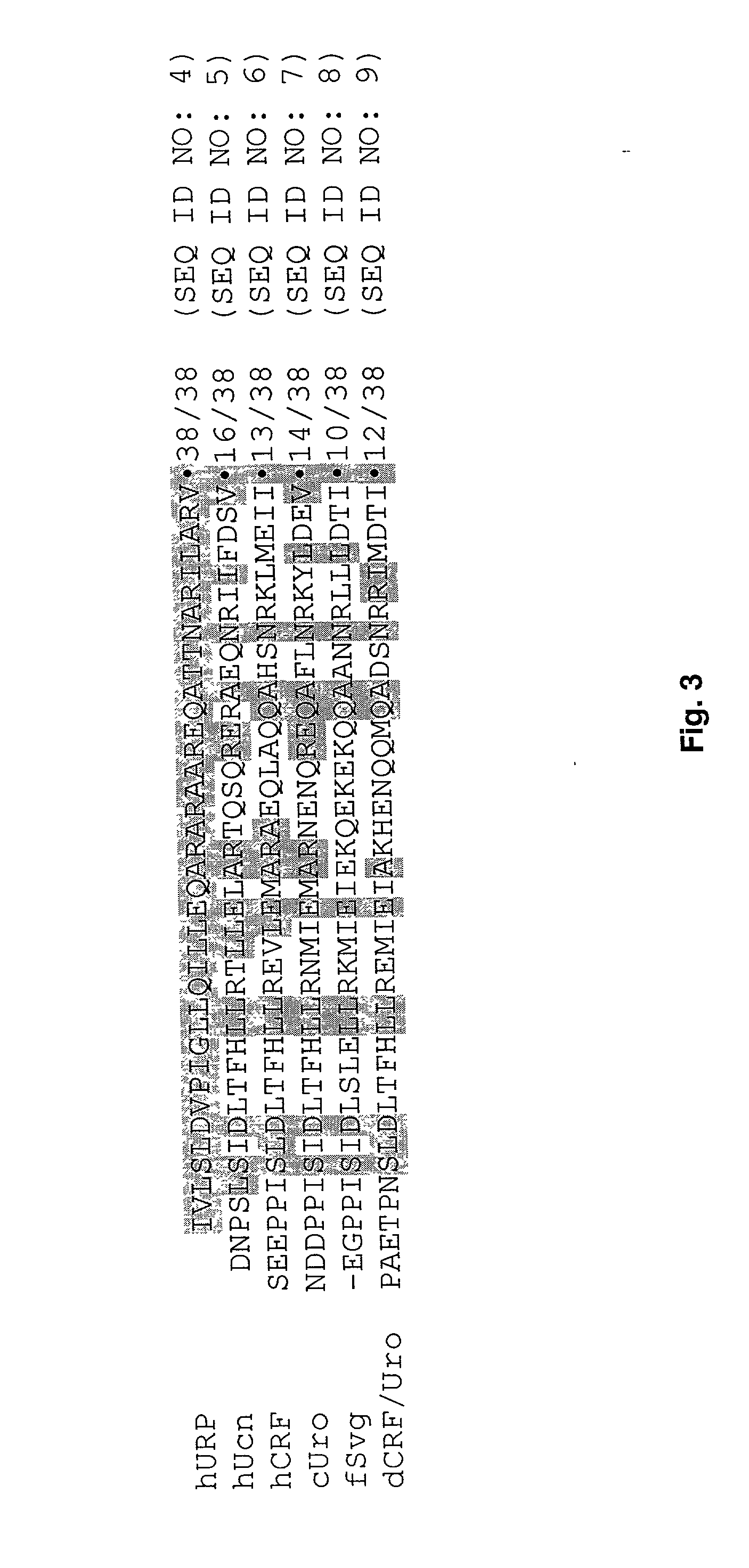Urocortin proteins and uses thereof
a technology of urocortin and proteins, applied in the field of neuroendocrinology and the mechanisms involved in stress, can solve the problems of deficiency in the recognition of additional urocortin genes and proteins in the early art, and achieve the effect of reducing food intak
- Summary
- Abstract
- Description
- Claims
- Application Information
AI Technical Summary
Benefits of technology
Problems solved by technology
Method used
Image
Examples
example 1
Identification of Human Urocortin-related Protein
[0091] In an effort to identify novel CRF-R ligands, a hidden Markov model (HMM) was constructed from a clustal W alignment of known CRF family proteins, including rat / human CRF, rat Ucn, human Ucn, frog sauvagine, and white-suckerfish urotensin I, using the HMMER software package (Sean Eddy, Department of Genetics, Washington University, St. Louis, Mo.; see ref. 19). This HMM was used to search the public human genome database and a BAC (Genbank accession no. AC005903) derived from chromosome 3p21.3-4 was identified that contained a 109 bp region exhibiting significant sequence homology but which was not a part of a previously identified gene. This region was extended to 621 bp with the identification of a human EST clone that overlapped with this sequence (Genbank accession No. BE622276). The human sequence, however, lacks a consensus proteolytic cleavage site that would allow for C-terminal processing of the peptide. Therefore, the...
example 2
Identification of Mouse Urocortin II
[0094] Fragmentary cDNA probes based on the human gene sequence specifically cross-hybridized with rat tissue (brain), suggesting that a reasonable degree of homology existed between the two species. Based on this human sequence, primers were designed to identify the homologous mouse gene by the Rapid Amplification of cDNA Ends (RACE) method. RACE -ready cDNA was prepared from mouse whole-brain poly(A+) RNA using the SMART RACE cDNA amplification kit (Clontech). PCR reactions were run under low stringency (low T.sub.m) conditions in an effort to allow for the maximal heterologous priming. First round amplification was carried out using a touchdown protocol (94.degree., 30 sec; increment from 70.degree. to 55.degree., 30 sec; 72.degree., 3 min) followed by a second round of amplification with multiple sets of nested primers (94.degree., 20 sec; 55.degree., 20 sec; 72.degree., 3 min). Candidate PCR products were cloned into pCRII-TOPO (Invitrogen) f...
example 3
Peptide Synthesis
[0097] Murine Ucn II and human Ucn-related peptide were synthesized manually using the solid phase approach, a methylbenzhydryl amine resin and the Boc-strategy (21). Trifluoroacetic acid, 60% in dichloromethane, was used to remove the Boc group. Main chain assembly was mediated by diisopropylcarbodiimide. The peptides were cleaved and deprotected in hydrofluoric acid and purified using RP-HPLC and three solvent systems (triethylammonium phosphate at pH 2.25 and 6.5 and / or 0.1% TFA) (22). Peptides were greater than 95% pure using independent HPLC and CZE criteria. Mass spectra was used to confirm the composition of the preparations.
PUM
| Property | Measurement | Unit |
|---|---|---|
| Angle | aaaaa | aaaaa |
| Temperature | aaaaa | aaaaa |
| Composition | aaaaa | aaaaa |
Abstract
Description
Claims
Application Information
 Login to View More
Login to View More - R&D
- Intellectual Property
- Life Sciences
- Materials
- Tech Scout
- Unparalleled Data Quality
- Higher Quality Content
- 60% Fewer Hallucinations
Browse by: Latest US Patents, China's latest patents, Technical Efficacy Thesaurus, Application Domain, Technology Topic, Popular Technical Reports.
© 2025 PatSnap. All rights reserved.Legal|Privacy policy|Modern Slavery Act Transparency Statement|Sitemap|About US| Contact US: help@patsnap.com



